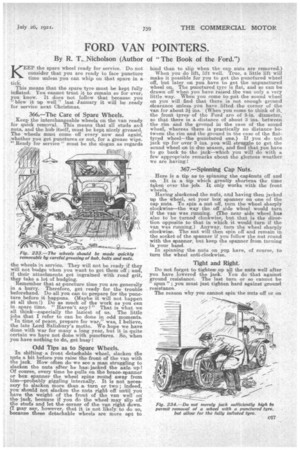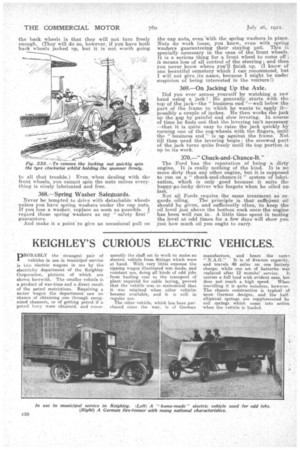FORD VAN POINTERS.
Page 25

Page 26

If you've noticed an error in this article please click here to report it so we can fix it.
By R. T, Nicholson (Author of "The Book of the Ford.")
KEEP the spare wheel ready for service. Do not consider that you are ready to face puncture , time unless you can whip on that spare in a tick.
This means that the spare tyre must he kept fully inflated. You cannot trust it to remain so for ever, you know. It doesnot follow that because you " blew it up well" last January it will be ready for service next Christmas.
366.—The Care of Spare Wheels.
Keep the interchangeable wheels on the van ready for quick removal. This means that all studs and nuts, and the hub itself, must be kept nicely greased. The wheels must come off every now and again', whether you get punctures or not, for a grease wipe. "Ready for service" must be the slogan as regards the wheels in service. They will not be ready if they will not budge when you want to get them off ; and, if their attachments get ingrained with road grit, they take a lot of budging. Remember that at puncture time you are generally in a hurry. Therefore, get ready for the trouble beforehand. Do all you can to prepare for the puncture before it happens. (Maybe it will not happen at all then?) Do as much of the work as you. can in spare time. "Haven't any?" That is what we all think—especially the laziest of us. The little jobs that I refer to can be done in odd moments. "In time. of peace, prepare for war," was, I believe, the late Lord Salisbury's motto. We hope we have done with war for many a long year, but it is quite certain we have not done with punctures. So, when you have nothing to do, get busy!
Odd Tips as to Spare Wheels.
In shifting a front detachable wheel, slacken tile nuts a bit before you raise the front of the van with the jack. How often do we see a man struggling to slacken the nuts after he has.. jacked the axle; up! Of course, every time he pulls on the brace spanner or box spanner the wheel spins round, away from him—probably giggling internally. It is not necessary to slacken more than a, turn or two ; indeed, you should not slacken the. nuts right off until you have the weight of the front of the van well on: the jack, because if you do the wheel may slip off tile studs and let the corner of the van right down. (I pay say, however, that it is not likely to do so, because these detachable wheels are more apt to
bind than to slip when the cap nuts are removed.)
When you do lift, lift well. True, a little lift will make it possible for you to get the punctured wheel off, but later on you have to get the unpunctured wheel on. The punctured tyre is flat, and so can be drawn off when you have raised the van only a very little way. When you come to put the • sound wheel on you will find that there is not enough ground clearance unless you have lifted . the corner of the van for about 3i ins. (When you come to think of it, the front tyres, of the Ford are of 3-in, diameter, so that there is a distance Of about 3 ins, between the rim and the ground in the case of the sound wheel, whereas there is practically no distance between the rim and the ground in the case of the flattyred wheel—the punctured one.) If you do not jack up for over 3 ins, you will struggle to get the sound wheel on in due season, and find that you have to go back -to the jack—which you will do with a few appropriate remarks about the glorious weather we are having!
367.—Spinning Cap Nuts. •
Here is a tip as to spinning the capinuts off and on. It is a tip which greatly shortens the time taken over the job. It only works with the front wheels.
Having slackened the nutS, and having then jacked up the wheel, set your box spanner on one of the cap nuts. To spin a nut off, turn the wheel sharply clockwise—the way the off side wheel would turn if the van was running. (The near side wheel has also to be turned clockwise, but that is the direction opposite to that in which it would turn if the van was running.) Anyway, turn the wheel sharply clockwise. The nut will then spin off and remain in the socket of the spanner if you follow the nut round with the spanner, but keep the spanner from turning in your hand.
In spinning the nuts on you have, of course, to turn the wheel anti-clockwise.
Tight and Right.
Do not forget to tighten up all the nuts well after you have .lowered the jack. You do that against ground resistance. The last turn or so cannot be "spun" ; you must just tighten hard against ground resistance.
The reason why you cannot spin the nuts off or on the back wheels is that they will not turn freely enough. (They will do so, however, if you have both back wheels jacked up, but it is not worth going to all that trouble.) Even when dealing with the front wheels, you cannot spin the nuts unless everything is nicely lubricated and free.
368.—Spring Washer Safeguards.
Never be tempted to drive with detachable wheels unless you have spring washers under the cap nuts. If you lose a washer, replace as soon as possible. I regard those spring washers as my " safety first '' guarantors.
And make it a. point to give an occasional pull on
the cap nuts, even-with the spring washers in place. Nuts do work loose, you know, . even with spring washers guaranteeing their staying put. This is specially necessary in the case of the front wheels. It is a serious thing for a front wheel. to' come off ; it means loss of all control of the steering; and then you never know where you'll finish up. (I know of one beautiful cemetery which I can recommend, but I will not. give its name, because I might be under suspicion of being interested in the venture!)
369.—On Jacking lip the Axle.
Did you ever a-muse yourself by watching a raw hand using a jack ? He generally starts with the top of the jack—the "business end "—well below the part of the frame to which he wants to apply it— possibly a couple of inches. He then works the jack up the gap by painful and slow levering. In course of time he finds out that the levering isn't necessary —that it is quite easy to raise the jack quickly by turning one of the cog-wheels with the fingers, until the " business end" is up against the frame. Not till then need the levering begin: the screwed part. of the jack turns quite freely until its top portion is up to its work.
370.—" Chuck-and-Chance-It."
The Ford has the reputation of being a dirty engine. It is really nothing of the kind. It is no more dirty than any other engine, but it is supposed to run on a " chuck-and-chance-it " system of lubrication, which is only good because it suits the happy-go-lucky driver who forgets when he oiled up last.
Not all Fords require, the same treatment as re
gards oiling. The principle is that sufficient oil should be given, and sufficiently often, to keep the. oil level just above the bottom cock once the engine has been well run in. A little, time spent in testing the level at odd times for a few days will show you just how much oil you ought to carry.
































